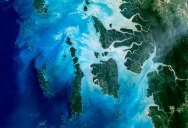15 Surreal Satellite Images of Earth
Across four decades since 1972, Landsat satellites have continuously acquired space-based images of the Earth’s land surface, coastal shallows, and coral reefs. The Landsat Program, a joint effort of the U.S. Geological Survey (USGS) and the National Aeronautics and Space Administration (NASA), was established to routinely gather land imagery from space. The result of this program is a long-term record of natural and human induced changes on the global landscape.
Each Landsat satellite images the Earth’s surface along the satellite’s ground track in a 185 kilometer-wide (115 mile-wide) swath as the satellite moves in a descending orbit (moving from north to south) over the sunlit side of the Earth. Each satellite crosses every point on the Earth at nearly the same time once every 16 or 18 days, depending on its altitude. Landsats 1, 2, and 3 orbited at an altitude of 920 kilometers (572 miles), circling the Earth every 103 minutes yielding repeat coverage every 18 days. Landsats 4, 5, and 7 were placed in orbit at 705 kilometers (438 miles) altitude, circling the Earth every 99 minutes, for a 16-day repeat cycle.
The Landsat Data Continuity Mission (LDCM) is the next-generation Landsat satellite and is expected to be launched no earlier than February 11, 2013. This mission will ensure the continued acquisition and availability of Landsat-like data well beyond the duration of the current Landsat 5 and Landsat 7
missions.
The Landsat satellites have a spectral band range from visible green to near-infared. As to why the colours can seem a little funky in the images, check out this fantastic presentation that discusses how Landsat images are made and the important distinction between photographs and images, especially when it concerns satellite imagery.
1. Mergui Archipelago, Myanmar

The Mergui Archipelago in the Andaman Sea consists of more than 800 islands. This natural-color image of the center portion of the archipelago was captured by Landsat 5 on Dec. 14, 2004.
2. Manicouagan Impact Structure
Quebec, Canada

This scene shows a glimpse of the Manicouagan Impact Structure in Quebec, Canada. Lake Manicouagan and Lake Mushalagan surround the central uplift of the crater. The original diameter of the crater was 62 miles (100 kilometers), and the age has been dated at 214 million years. Shattercones (striated features found in rocks deformed by the passage of shock waves), along with shattered and brecciated rocks found in the central uplift, confirm the crater’s impact origin. Several glacial advances have scoured the crater to its present form. It has been proposed that the impact was created by an asteroid with a diameter of about 3.1 miles (5 kilometers). June 1, 2001
3. Detroit, Michigan, USA

Detroit, Michigan, is commonly referred to as Motor City because of the many automobile manufacturing plants located in the city. It is the largest city in Michigan, with a population approaching one million. December 11, 2001
4. Belcher Islands, Canada

Like sweeping brushstrokes of pink and green, the Belcher Islands meander across the deep blue of Canada’s Hudson Bay. The islands’ only inhabitants live in the small town of Sanikiluaq, near the upper end of the middle island. Despite the green hues in this image, these rocky islands are too cold to sustain more than a smattering of low-growing vegetation. September 21, 2001
5. Baghdad, Iraq April 2003

Fires from coalition bombing during the second war in Iraq provided a dramatic, smoke-filled image over Baghdad. The Tigris River snakes north to south in this image. Baghdad International Airport is west of the smoke. April 2, 2003
6. Brandberg Massif, Namibia

Brandberg Massif is a dome-shaped granite intrusion that covers 250 square miles (650 square kilometers) and rises 1.6 miles (2,573 meters) above its surroundings in the central Namib Desert. Brandberg Massif is an important habitat for high-altitude savannah species and is of great archaeological interest due to the many prehistoric cave paintings found among its granite cliffs. September 10, 2002
7. Growth in the Desert – Las Vegas

These images from 1984 and 2007 show the increasing urban sprawl of Las Vegas, Nevada, and the shrinking of Lake Mead on the border of Nevada and Arizona. Rapid growth in Las Vegas has led to increased demand for water resources, while below-average rainfall has decreased the water levels in Lake Mead, which is the source of 90 percent of southern Nevada’s water. 1984/2007
8. Mt. Fuji and Fuji Five Lakes area, Japan

The Fuji Five Lakes area, with Mt. Fuji as the centerpiece, is one of Japan’s most popular tourist destinations. Mt. Fuji, as Japan’s highest peak at 12,388 feet (3,776 meters), is a dormant volcano that last erupted in 1707. October 4, 2002
9. Aral Sea

The Aral Sea, once the 4th largest lake in the world, continues to shrink and is now 10% of its original size. U.N. Secretary General Ban Ki-moon recently called the drying up of the Aral Sea on of the planet’s most shocking disasters. Feeder streams to the sea have been diverted by irrigation and by the completion of upstream dam projects. The result has been the ruin of the local fishing and shipping economy, and wind-carried salty sands have created regional health problems. May 29, 1973/October 18, 2009
10. Houston, Texas, USA

Houston, situated on the Gulf of Mexico and home to 2.14 million people, is the nation’s fourth largest city and a hub of international business. The Houston Ship Canal connects the Port of Houston to the Gulf of Mexico through Galveston Bay. December 22, 2000
11. Wabash and Ohio Rivers

These two images show the Wabash and Ohio Rivers near Evansville, Indiana, while flooded (May 3, 2011, top image) and after the waters had receded (June 4, 2011, bottom image). Landsat 5 took these natural-color images with its Thematic Mapper. May 3, 2011/June 4, 2011
12. Philadelphia, Pennsylvania, USA

Philadelphia is the sixth largest city in the United States. Much of America’s early history took place in Philadelphia, including the signing of the Declaration of Independence. Serving a short term as the Nation’s Capitol (1790 -1800), the town was the home of Washington and Adams during their presidency. April 24, 2002
13. Lake Powell, Utah, USA

Lake Powell stretches hundreds of miles from Lees Ferry in Arizona to the Orange Cliffs of southern Utah. At more than 400 feet (122 meters) deep, 150 miles (241 kilometers) long, and with nearly 2,000 miles (3,219 kilometers) of shoreline, Lake Powell is the nation’s second largest man-made lake, second only to Lake Mead in Nevada. In 2004, it was at its lowest water level in over 30 years due to the ongoing drought in the western United States. June 1, 2004
14. Nazca Lines, Peru

In the desert of southwest Peru, between the Andes Mountains and the Peruvian coast, lies a plateau with huge geometric patterns and spirals, animal figures including a monkey, a spider, and an ‘owl man,’ and thousands of perfectly straight lines. The last of these was drawn about a thousand years ago. Known as the Nazca lines, the drawings have mystified scientists since they were first discovered in the 1920s. Pictured here is all that can be seen of these lines by Landsat 7’s 15 meter pan band, which has been used to sharpen the 30 meter Bands 3, 2, and 1. November 10, 2002
15. Singapore

Just over 3.5 times the size of Washington, D.C., Singapore’s population is 100% urban (over 4.7 million people). This image was created with bands 7,4,2 to minimize the atmospheric effects of haze and humidity. February 8, 2009
If you enjoyed this post, the Sifter
highly recommends:

Sign up to get our BEST stories of the week straight to your inbox.




